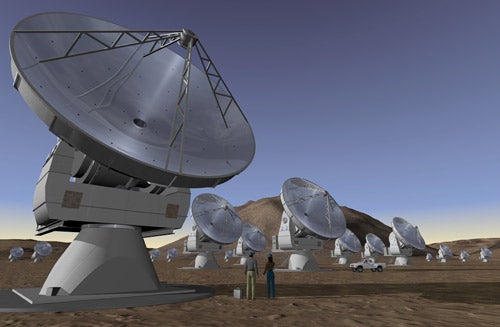An important piece of equipment for the Atacama Large Millimeter/submillimeter Array (ALMA) project shipped this week. The first European-built receiver system is headed for ALMA’s home in Chile’s Atacama Desert from the Science and Technology Facilities Council’s Rutherford Appleton Laboratory (RAL) in Oxfordshire, United Kingdom. Reports indicate the system will arrive in Chile March 28.
ALMA is a huge set-up of 66 individual antennas, 39- and 23-foot (12- and 7- meter) diameter, that when electronically combined simulate a telescope diameter of up to 9 miles (15 kilometers) – more than a thousand times the size of a single antenna. The telescope operates in the millimeter and submillimeter wavelength window, which is invisible to the human eye and lies between the infrared and radio regions of the electromagnetic spectrum.
Its vast size will allow astronomers to detect signals within and outside our galaxy with greater clarity than has previously been possible. ALMA will be used to detect and study the earliest and most distant galaxies, and it will also probe deep into dust-obscured regions where visible-light observations cannot be made and allow us to investigate the birthplace of stars and planets.
The receiver, which will be the first from Europe to be added to the array (the first was sent from the United States last year), is a vital component that detects the extremely faint signals from space. This is the first of 26 units to be sent to Chile from the European Front-End Integration Center (FEIC) over a 3-year period. RAL was awarded the contract from the European Southern Observatory (ESO) in late 2007, because of its substantial heritage and expertise in the field of millimeter and submillimeter wave technology, and its large-scale facilities that are ideally suited to the FEIC infrastructure requirements.
“This is a major milestone for the ALMA project and in particular with respect to its European contribution,” said Brian Ellison, ALMA project manager. “Expert teams in Europe, North America, and East Asia have combined their skills to produce cutting edge technology for ALMA. I am delighted that the United Kingdom, in addition to its many other technical and scientific contributions to the array, is playing such a vital and successful role in the provision of the core receiver technology”.
“We are very happy to provide the first European receiver to the observatory in Chile,” said Wolfgang Wild, ALMA project manager at ESO. “These receivers contain the finest state-of-the-art technology from Europe, North America, and East Asia”.
“This delivery involves the most advanced submillimeter receiver currently available in the world,” said Gie Han Tan from ESO, manager responsible for all European ALMA front-end activities. “I’m proud to have been working towards this important milestone with colleagues from all ALMA partners and within ESO. It is the result of many years of development, very hard work and commitment of all contributors”.










